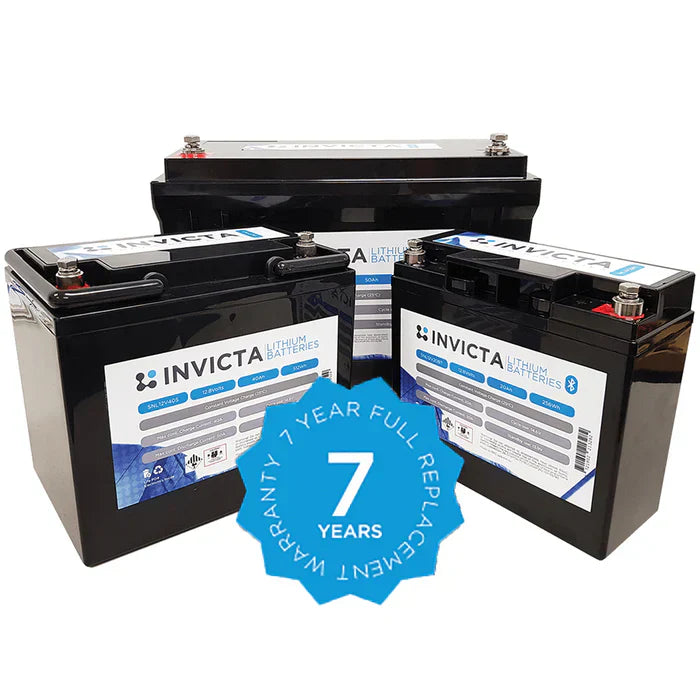Lithium batteries have revolutionised energy storage across various industries, offering longer lifespan, better efficiency, and superior reliability compared to traditional lead-acid and AGM batteries. Whether you rely on lithium batteries for solar energy storage, caravan and camping setups, marine applications, or 4WD power systems, proper maintenance is essential to maximise their performance and longevity.
While lithium batteries are known for being low-maintenance, neglecting proper charging, storage, and handling can significantly shorten their lifespan. A well-maintained lithium battery can last over 10 years or 5,000 charge cycles, whereas improper use can lead to early degradation, power loss, or even failure within a few years.
In this guide, we’ll cover everything you need to know about lithium battery maintenance, including best charging practices, storage tips, and common mistakes to avoid.
Looking for a high-quality lithium battery? Explore our range at DC Direct.
Understanding Lithium Battery Lifespan
Lithium batteries are typically rated by charge cycles, which refer to the number of times a battery can be fully charged and discharged before its capacity starts to degrade.
Typical Lifespan of Lithium Batteries vs Other Battery Types
|
Battery Type |
Charge Cycles |
Lifespan (Years) |
|
Lithium Iron Phosphate (LiFePO4) |
2,000 – 5,000 |
10 – 15 years |
|
Lead-Acid / AGM |
500 – 1,000 |
3 – 5 years |
|
Gel Batteries |
1,000 – 1,500 |
5 – 7 years |
While lithium batteries naturally last longer than other types, how you use and maintain them will determine whether you reach the upper range of their lifespan.
Learn more about lithium battery technology and its benefits.
Essential Maintenance Tips to Extend Lithium Battery Life
1. Follow Proper Charging Practices
Incorrect charging is one of the fastest ways to reduce the lifespan of a lithium battery. Unlike lead-acid batteries, lithium batteries do not require trickle charging or equalisation charging, and they function best when charged within specific voltage and temperature limits.
Best Charging Practices for Lithium Batteries
- Always use a lithium-compatible charger that matches the voltage and amperage specifications of your battery.
- Charge the battery before it drops below 20% capacity to prevent excessive discharge.
- Avoid overcharging – most lithium batteries have a built-in Battery Management System (BMS) to prevent this, but always use a regulated charger to ensure safe charging.
- Do not charge the battery in extreme temperatures (below 0°C or above 45°C), as this can cause long-term damage.
Using a solar charging system? Make sure you have an MPPT (Maximum Power Point Tracking) charge controller, which optimises solar energy input for lithium batteries.
For more information on rechargeable battery charging techniques, check out our Rechargeable Batteries Guide.
2. Prevent Deep Discharges
Deep discharging occurs when a battery is drained too low before being recharged. While lithium batteries can handle deeper discharges than lead-acid alternatives, frequent deep cycling (below 10% capacity) can shorten their lifespan.
How to Avoid Deep Discharge
- Use a low-voltage disconnect (LVD) device to automatically cut power before the battery reaches a critically low level.
- Recharge your battery as soon as possible when it drops to 20-30% capacity.
- Monitor power consumption with a battery monitor to track real-time voltage levels.
3. Store Lithium Batteries Correctly
If you’re not using your lithium battery for an extended period, proper storage is crucial to prevent degradation.
Best Storage Practices
- Store the battery at 50% charge to prevent long-term voltage imbalance.
- Keep it in a cool, dry location with a temperature range of 10°C to 25°C.
- Avoid direct sunlight, humidity, or exposure to water, which can damage the battery casing and internal components.
- If storing for longer than six months, check and recharge the battery every 3-6 months to prevent excessive self-discharge.
Learn more about battery management in our BMPRO Battery Management System guide.
4. Keep the Battery Terminals and Connections Clean
Dirt, dust, and corrosion can interfere with power transmission, leading to voltage drops and reduced efficiency.
Cleaning and Maintenance Tips
- Periodically inspect battery terminals and connectors for signs of corrosion or buildup.
- If necessary, clean the terminals with a dry cloth and a small amount of contact cleaner.
- Ensure all cable connections are tight and secure to prevent power loss.
5. Protect Your Battery from Extreme Temperatures
Lithium batteries are designed to operate within a specific temperature range. Exposure to extreme heat or cold can negatively impact performance and lifespan.
How to Protect Against Temperature-Related Damage
- Avoid charging below 0°C or above 45°C, as extreme temperatures can cause irreversible internal damage.
- If using lithium batteries in cold weather, consider a heated lithium battery that includes built-in temperature regulation.
- In hot environments, ensure proper ventilation and avoid placing batteries in direct sunlight.
For a deeper comparison of battery performance in different conditions, read our guide on Choosing the Best Lithium Battery.
Common Mistakes That Shorten Lithium Battery Life
Even with proper maintenance, certain mistakes can significantly reduce the lifespan of a lithium battery. Avoid the following:
-
Using an incompatible charger – Always use a charger designed for lithium batteries to prevent voltage mismatch.
-
Fully discharging the battery – Allowing a lithium battery to drop to 0% repeatedly will damage its cells.
-
Overloading the battery – Connecting appliances that exceed the battery’s rated capacity can cause overheating and premature failure.
-
Ignoring regular inspections – Periodically check voltage levels, connections, and overall battery condition.
Conclusion: Proper Care Extends the Life of Your Lithium Battery
Lithium batteries are a long-term investment, offering high energy efficiency, reliability, and a long lifespan. By following the charging best practices, storage guidelines, and maintenance tips outlined in this guide, you can ensure your battery lasts for years while maintaining peak performance.
If you’re looking for a durable, high-quality lithium battery, check out our range at DC Direct.

